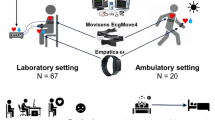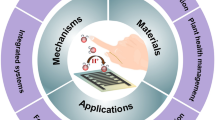Abstract
To determine the impact of wearing an N95 filtering facepiece respirator (N95 FFR) on tympanic temperature measurements. TMT measurements, with and without wearing an N95 filtering facepiece respirator (N95 FFR) were obtained at the onset and termination of 1 h of treadmill exercise in 21 subjects, and at staggered time intervals (0, 20, 40, 60 min) during combined sedentary activity and exercise of another 46 subjects, to determine any effect on TMT. A total of 877 TMT measurements were obtained that demonstrated a mean TMT increase of 0.05 °C in the first study group (p = 0.04) and a 0.19 °C decrease in the second study group (p < 0.001) with the wearing of an N95 FFR, both of which were lower than controls. Wearing an N95 FFR for 1 h, at different levels of activity, results in significantly lower TMT values than not wearing an N95 FFR, but the magnitude of the changes would likely have minimal clinical significance.
Similar content being viewed by others
References
van Staaij BK, Rovers MM, Schilder AG, Hoes AW. Accuracy and feasibility of daily infrared tympanic membrane temperature measurements in the identification of fever in children. Int J Pediatr Otorhinolaryngol. 2003;67:1091–7.
El-Radhi AS, Barry W. Thermometry in paediatric practice. Arch Dis Child. 2006;91:351–6.
McCaffrey TV, McCook RD, Wurster RD. Effect of head skin temperature on tympanic and oral temperature in man. J Appl Physiol. 1975;39:114–8.
Kamitani K, Higuchi A, Takebayashi T, Miyamoto Y, Yoshida H. Covering the head and face maintains intraoperative core temperature. Can J Anaesth. 1999;46:649–52.
Koehn J, Kollmar R, Cimpianu C-L, et al. Head and neck cooling decreases tympanic and skin temperature, but significantly increases blood pressure. Stroke. 2012;43:2142–8.
Roberge RJ, Kim J-H, Coca A. Protective facemask impact on human thermoregulation: an overview. Ann Occup Hyg. 2012;56:102–12.
Roberge RJ, Benson S, Kim J-H. Thermal burden of N95 filtering facepiece respirators. Ann Occup Hyg. 2012;56:808–14.
Roberge RJ, Kim J-H, Benson SM. Absence of consequential changes in physiological, thermal and subjective responses from wearing a surgical mask. Respir Physiol Neurobiol. 2012;181:29–35.
National Institute for Occupational Safety and Health (NIOSH). Respirator usage in private sector firms, 2001. http://www.cdc.gov/niosh/docs/respsurv/pdfs/respsurv2001.pdf (2003). Accessed 10 Jan 2014.
Yip WL, Leung LP, Lau PF, Tong HK. The effect of wearing a face mask on body temperature. Hong Kong J Emerg Med. 2005;12:23–7.
Gosch ME, Shaffer RE, Eagan AE, Roberge RJ, Davey VJ, Radonovich LJ Jr. B-95: a new respirator for health care personnel. Am J Infect Control. 2013;41:1224–30.
Roberge RJ, Kim J-H, Powell JB. N95 respirator use during pregnancy. Am J Infect Control. 2014;42:1097–100.
Kim J-H, Roberge RJ, Powell J, Shaffer RE, Ylitalo CM, Sebastian JM. (2015). Pressure drop of filtering facepiece respirators: how low should we go? Int J Occup Med Environ Health (in press).
Occupational Safety and Health Administration (OSHA). Respiratory Protection Standard 1910.134. http://www.osha.gov/pls/oshaweb/owadisp.show_document?p_id=12716&p_table=standards (1998). Accessed 11 Feb 2014.
do Nascimento VR. Evaluation of thermometers for ear temperature measurement at the wards in a university hospital. Dissertation for Master’s Degree in Biomedical Engineering. Portugal: Nova University of Lisbon; 2012. http://run.unl.pt/bitstream/10362/8480/1/Nascimento_2012.pdf. Accessed 14 Jan 2014.
Graveline R, MacCalman L, Cowie H. The use of infra-red (tympanic) temperature as a guide to signs of heat stress in industry. United Kingdom, health and safety executive, research report 989. http://www.hse.gov.uk/research/rrpdf/rr989.pdf (2013). Accessed 14 Jan 2014.
Sund-Levander M, Forsberg C, Wahren LK. Normal oral, rectal, tympanic and axillary body temperature in adult men and women: a systematic literature review. Scand J Caring Sci. 2002;16:122–8.
Kim J-H, Benson SM, Roberge RJ. Pulmonary and heart rate responses to wearing N95 filtering facepiece respirators. Am J Infect Control. 2013;41:24–7.
Roberge RJ, Coca A, Williams WJ, Powell JB, Palmiero AJ. Physiological impact of N95 filtering facepiece respirator on healthcare worker. Respir Care. 2012;55:569–77.
McCormack MC, Wise RA. Respiratory physiology in pregnancy. In: Bourjeily G, Rosene-Montella K, editors. Pulmonary Problems in Pregnancy. New York: Springer/Human Press; 2009. p. 19–26.
Wu S, Harber P, Yun D, Bansal S, Li Y, Santiago S. Anxiety during respirator use: comparison of two respirator types. J Occup Environ Hyg. 2011;8:123–8.
Tendorf A. The effects of cooling core body temperature on overall strength gains and post-exercise recovery. Stanford Word Press; 2003. http://www.stanford.edu/group/journal/cgi-bin/wordpress/wp-content/uploads/2012/09/Tenforde_NatSci_2003.pdf. Accessed 25 March 2014.
Wenger CB. Exercise and core temperature. Army Research Institute of Environmental Medicine, report ADA 377492. http://www.dtic.mil/dtic/tr/fulltext/u2/a377492.pdf (1999). Accessed 25 March 2014.
Rebmann T, Carrico R, Wang J. Physiologic and other effects and compliance with long-term respirator use among medical intensive care unit nurses. Am J Infect Control. 2013;41:1218–23.
Acknowledgments
Financial support for this study came from internal operating funds of the National Personal Protective Technology Laboratory/National Institute for Occupational Safety and Health/Centers for Disease Control and Prevention.
Conflict of interest
The authors declare that they have no conflict of interest.
Author information
Authors and Affiliations
Corresponding author
Additional information
Disclaimer: The findings and conclusions in this report are those of the author(s) and do not necessarily represent the views of the National Institute for Occupational Safety and Health. Mention of product names does not imply endorsement.
The authors declare that the experiments comply with the current laws of the United States of America.
Rights and permissions
About this article
Cite this article
Kim, JH., Roberge, R.J. & Powell, J.B. Effect of wearing an N95 respirator on infrared tympanic membrane temperature measurements. J Clin Monit Comput 29, 691–695 (2015). https://doi.org/10.1007/s10877-014-9651-x
Received:
Accepted:
Published:
Issue Date:
DOI: https://doi.org/10.1007/s10877-014-9651-x




